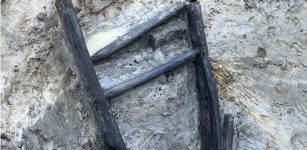6,000-Year-Old Vast Settlement With Tools And Granite Structures Unearthed In Sotta, Corsica In France
Conny Waters - AncientPages.com - A team of archaeologists from INRAP (French National Institute for Preventive Archaeological Research) recently unearthed two Neolithic settlements of which one has well-preserved structures.
The excavataed arc was the best preserved of its kind at the site, experts said. Image credit: Florian Soula INRAP
INRAP researchers inform that the remains of this vast settlement are located on the slopes of the southern flank of Punta Campana, in Sotta, and include a large number of ancient artifacts.
In the first settlement that dates to the beginning of the fourth millennium B.C to about 6,000 years ago, researchers found a stone structure filled with remains of an obsidian cutting workshop. This part of the excavated place was found to be partially eroded.
The second settlement dates to the third millennium BC., about 4,000-5,000 years ago, it was better preserved, and there, the team uncovered a system of terraces, topped with an approximately 3-foot tall or fortified wall made of granite blocks, according to researchers. The structures were excavated between November 2022 and March 2023,.
General view of a bastion being excavated in Sotta (Southern Corsica) in 2023. © Florian Soula, Inrap
“The top of the excavation right-of-way presents a more complex organization, with a "bastion" supported by an imposing terrace wall, fully preserved and measuring about 0.9 to 1.2 m in height compared to the level of circulation preserved. This wall is built of large granite blocks with an upper base of blocks laid flat,” according to INRAP press release.
On the first terrace below it was a stone arc also made from granite blocks. The building techniques used in the arc indicate it was used as some kind of roof, but experts are investigating its exact purpose, they said. The excavataed arc was the best preserved of its kind at the site.
Within the terraced structure, researchers discovered a corridor and staircase that probably functioned as a passageway to the upper level of the system. .
Among the smaller remains were artifacts indicating artisan practices in daily life, researchers said. Florian Soula INRAP
Within the corridor, several vases were unearthed. A pear-shaped vase was among several vases discovered on the paving inside the wall of the terraced structure
Also, two other similar terraced systems were found at the site; but for now, their purpose is unclear. Possibly they were used for food storage, metallurgy, or other artisans' activities.
The excavating team discovered many unusual artefacts at the Neolithic site and particularly, in the terraced section. These include thousands of unusual copper and other metal artifacts, obsidian, quartz, pieces of flint, wheels, arrowheads; axes, and other metal objects.
 A storage vase was also found among the artifacts, experts said. Florian Soula INRAP
A storage vase was also found among the artifacts, experts said. Florian Soula INRAP
Some remains show traces of melting that took place at the site. There were also cattle teeth and rare cranial skeletal remains that seemed to have been burned, INRAP informed.
Other artifacts gave experts greater insight into life during the Neolithic era and at the settlement in particular. Among the smaller remains were artifacts indicating artisan practices in daily life, researchers said.
The artifacts indicate the presence of intense and/or long-term activities concerning all aspects of daily life and economy of Neolithic societies.
Further studies will no doubt will help to obtain give a greater view into ancient life of the ancient societies in Sotta on the island of Corsica.
Written by Conny Waters - AncientPages.com Staff Writer
More From Ancient Pages
-
 Prophet King Phineus Revealed The Future To Humans And Unleashed God Zeus’ Fury
Featured Stories | Nov 20, 2019
Prophet King Phineus Revealed The Future To Humans And Unleashed God Zeus’ Fury
Featured Stories | Nov 20, 2019 -
 Five Witchcraft Myths Debunked By An Expert
Featured Stories | Oct 27, 2023
Five Witchcraft Myths Debunked By An Expert
Featured Stories | Oct 27, 2023 -
 Princess Mkabayi KaJama: Condemned And Hated Zulu Kingmaker Who Died A Lonely Woman
Featured Stories | Mar 20, 2019
Princess Mkabayi KaJama: Condemned And Hated Zulu Kingmaker Who Died A Lonely Woman
Featured Stories | Mar 20, 2019 -
 Breakthrough! Evidence Of Previously Unknown Prehistoric Humans Who Lived In Europe More Than 1.1 Million Years Ago!
Evolution | Mar 13, 2025
Breakthrough! Evidence Of Previously Unknown Prehistoric Humans Who Lived In Europe More Than 1.1 Million Years Ago!
Evolution | Mar 13, 2025 -
 3,500-Year-Old Stone Inscribed With A Curse Against The City’s Governor Discovered In Jerusalem
Archaeology | Jul 13, 2022
3,500-Year-Old Stone Inscribed With A Curse Against The City’s Governor Discovered In Jerusalem
Archaeology | Jul 13, 2022 -
 Unexplained Mystery Of The Ship Of Horror – An Unsettling Story
Featured Stories | Aug 22, 2024
Unexplained Mystery Of The Ship Of Horror – An Unsettling Story
Featured Stories | Aug 22, 2024 -
 Incredibly Well-Preserved 1,000-Year-Old Wooden Ladder Discovered In The UK
Archaeology | Apr 30, 2022
Incredibly Well-Preserved 1,000-Year-Old Wooden Ladder Discovered In The UK
Archaeology | Apr 30, 2022 -
 1,000-Year-Old Coin And Other Finds Unearthed During Excavations At Carrignacurra Castle in Cork
Archaeology | Oct 6, 2022
1,000-Year-Old Coin And Other Finds Unearthed During Excavations At Carrignacurra Castle in Cork
Archaeology | Oct 6, 2022 -
 Egyptian King Seti I Documented His 3300-Year-Old Accomplishment On Triumphal Stele
Archaeology | Feb 27, 2023
Egyptian King Seti I Documented His 3300-Year-Old Accomplishment On Triumphal Stele
Archaeology | Feb 27, 2023 -
 Nine-Headed Bird: Mythical Creature Worshiped In Ancient China
Chinese Mythology | Oct 29, 2016
Nine-Headed Bird: Mythical Creature Worshiped In Ancient China
Chinese Mythology | Oct 29, 2016 -
 Lavish Home And Exotic Garden Of Emperor Caligula Discovered In Rome
Archaeology | Nov 19, 2020
Lavish Home And Exotic Garden Of Emperor Caligula Discovered In Rome
Archaeology | Nov 19, 2020 -
 Syamantaka – Divine Jewel With Magical Powers Was A Gift From The Sun God In Hindu Mythology
Featured Stories | Mar 1, 2019
Syamantaka – Divine Jewel With Magical Powers Was A Gift From The Sun God In Hindu Mythology
Featured Stories | Mar 1, 2019 -
 Çatalhöyük – 9,000 Years Ago: Overcrowding, Infectious Diseases, Violence And Environmental Problems Of Early Farmers
Archaeology | Jun 18, 2019
Çatalhöyük – 9,000 Years Ago: Overcrowding, Infectious Diseases, Violence And Environmental Problems Of Early Farmers
Archaeology | Jun 18, 2019 -
 America’s Oldest City Caral Illegally Invaded And Archaeologist Threatened With Death
Archaeology | Jan 21, 2021
America’s Oldest City Caral Illegally Invaded And Archaeologist Threatened With Death
Archaeology | Jan 21, 2021 -
 Mysterious Kolob – Does The Sacred Star Of The Mormons Exist?
Featured Stories | Feb 4, 2019
Mysterious Kolob – Does The Sacred Star Of The Mormons Exist?
Featured Stories | Feb 4, 2019 -
 Mystery Of The Maya Blue Pigment And Its Unusual Chemical Composition
Ancient History Facts | Mar 23, 2016
Mystery Of The Maya Blue Pigment And Its Unusual Chemical Composition
Ancient History Facts | Mar 23, 2016 -
 Collapse Of Akkadian Empire Strongly Related To Catastrophic Climate Change
Archaeology | Oct 28, 2019
Collapse Of Akkadian Empire Strongly Related To Catastrophic Climate Change
Archaeology | Oct 28, 2019 -
 Fossilized Remains Of A Gigantic Jurassic Pterosaur Unearthed In Oxfordshire, UK
Fossils | Jun 5, 2024
Fossilized Remains Of A Gigantic Jurassic Pterosaur Unearthed In Oxfordshire, UK
Fossils | Jun 5, 2024 -
 LIDAR Images Reveal Cambodia’s Greater Angkor Region Was Home To 700,000-900,000 People
Archaeology | May 8, 2021
LIDAR Images Reveal Cambodia’s Greater Angkor Region Was Home To 700,000-900,000 People
Archaeology | May 8, 2021 -
 Osiris: Enigmatic And Powerful God In Ancient Egypt
Egyptian Mythology | Jun 13, 2017
Osiris: Enigmatic And Powerful God In Ancient Egypt
Egyptian Mythology | Jun 13, 2017



